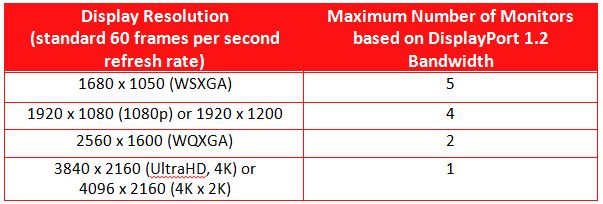Video suggestions
HDMI vs DVI vs DisplayPort.
Single-link DVI
-> Up to 1920x1200 at 8-bit colors at 60Hz. (more colors (10-bit per channel) can be achieved at lower resolution. This note applies to all, but lets focus on resolution more, so at it's max resolution, this is what it can provide)
-> Lock system (screws) to hold the connector in place so that it provide a reliable connection.
-> Error correcting bits to ensure the best image at every frame
-> Semi-expensive to make wires to the twisted pins, and many wires
-> No royalty fees
-> Support HDCP copy protection (added later on due to HDMI to allow Blu-ray support on PCs)
-> Max length 15ft, but can go longer at lower resolutions.
-> Carries video only
-> Open standard
Dual Link DVI
-> Exactly single link DVI
-> Kinda like a hacked up single DVI to get an increase of bandwidth to support higher resolutions
-> Max resolution: 2560x1600 at 8-bit colors at 60Hz OR 1920x1080 at 8-bit colors at 144Hz
-> Carries video only
HDMI
-> Max resolution: 1920x1200 at 8-bit colors at 60Hz
-> Newer HDMI version (1.4) can do: 4K at 8-bit colors at 30Hz
-> No error correction. The TV or monitor handles that themselves with guess work (increase cost of implementation)
-> No max length specified in the specification, meaning you have 0 reliability that long cables will work. This is probably because its targeted at TV's, so you most likely won't need anything above 6ft. They are 50ft cables and are reports that they work.. I am not saying it does not work.
-> Super high royalty fees.
-> Newer revision of HDMI has more expensive royalty fees, resulting in the marketing having trouble adapting to newer HDMI standard which creates compatibility problem
-> Does not provide a plug-in and it works experience (as you can see on this very forum), due to the above point. Usually it works fine on TV's as people get everything new at the same time. Or get fancy models of products where the manufacture spend the time and money (and cost on the device) to properly support all versions.
-> carries audio and video
-> Newer revision of HDMI can carry Ethernet
-> Backward compatible down to single-link DVI
DisplayPort / mini-DisplayPort / Micro-DisplayPort (coming this year)
-> Low power consumption compared to the above connector, making it ideal for mobile computers and tablets.
-> Carries video and audio, and auxiliary (can be USB for example or Ethernet, but so far, they are no consumer product that supports that.)
-> Max resolution: 4K at 10-bit colors at 60Hz
-> It's high bandwidth support up to 16-bit colors. Yes, 16-bit colors per channel!
-> Error correcting bits
-> 128-bit AES DisplayPort Content Protection (DPCP),
-> 40-bit High-bandwidth Digital Content Protection (HDCP)
-> DisplayID - replaces E-EDID (display identification protocol), which support 3D monitors and embedded display. It is designed to provide the best plug in play experience.
-> Can be controller-less for even more low power operation (eDP and Direct Drive Monitor) - this is used for powering mobile computers and tablets internal displays. So it helps increase the device battery life by consuming less power. It can also allow low cost monitor to be made.
-> Wireless DP (wDP). Support the ability to drive a monitor without a cable.
-> SlimPort. Support the ability to pass video and audio signal through a mico-USB cable. It is an energy-efficient alternative to Mobile High-Definition Link (MHL).
Still not cool enough for you?
-> Coming this year: DockPort. Includes USB 3.0 inside, and more power is transferred to drive a proper dock, with the ability to charge your devices on it.
-> Coming this year: DisplayPort 1.3, with 8K support at 60Hz
-> Coming this year: Micro DisplayPort
-> Daisy chain monitor form 1 plug from your device (any device, could be your laptop, desktop, tablet, or even phone)

-> Low EMI. Ideal for sensitive equipment like driving displays in medical and surgical equipment
-> Self-latching connector (full size only)
-> Low cost to manufacture than DVI and HDMI, and low cost implementation
-> Royalty-free
-> Backward compatible down to HDMI and single link DVI
-> Open standard
-> Max length: 6ft. However, like HDMI, longer cables can be made. DP group certifies that DP will work at 2 meter (~6.5ft) at 2560x1600. So if you need a solid guaranty, you have it.
-> Supports more plug-in's and out than HDMI and DVI, making it ideal for phones, tablets, laptops and projectors. Basically anything that will get a lot of plug-in and out wear.
So. Which is the best?
Well, I am no expert, but I think it's fairly obvious ![]()
However, if you wonder about input lag and image quality. All will give you the best image quality (it's all digital, there is no difference. Sure HDMI doesn't have error correction bits, but I don't think you'll notice the wrong color on one pixel, on 1 frame, that appeared after several minute or even hours of operation). All will give you low input lag.



















Create an account or sign in to comment
You need to be a member in order to leave a comment
Create an account
Sign up for a new account in our community. It's easy!
Register a new accountSign in
Already have an account? Sign in here.
Sign In Now